Click on images to enlarge

large infestation (Photo: Land Protection, QDNRW)
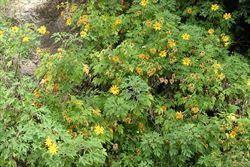
infestation (Photo: Chris Gardiner)

habit prior to flowering (Photo: Sheldon Navie)
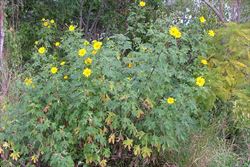
habit in flower (Photo: Sheldon Navie)
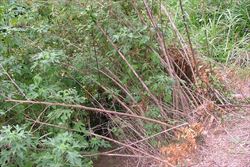
older plants with woody stems (Photo: Sheldon Navie)
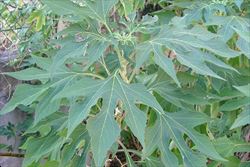
deeply-lobed leaves (Photo: Sheldon Navie)
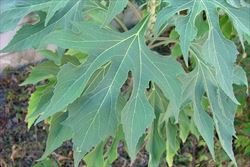
five-lobed leaf with tapered base (Photo: Sheldon Navie)

large flower-heads (Photo: Sheldon Navie)
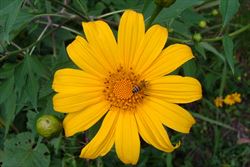
bright yellow flower-head (Photo: Sheldon Navie)
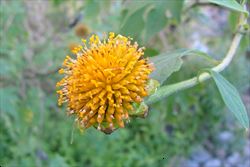
old flower-head with young fruit beginning to develop (Photo: Sheldon Navie)
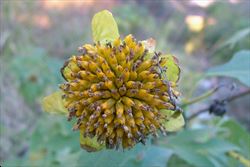
immature fruit (Photo: Sheldon Navie)

mature fruit (Photo: Sheldon Navie)

seedling (Photo: Sheldon Navie)
Scientific Name
Tithonia diversifolia (Hemsl.) A. Gray
Synonyms
Mirasolia diversifolia Hemsl.
Family
Asteraceae (Queensland, New South Wales, the ACT, Victoria, Tasmania, Western Australia and the Northern Territory)Compositae (South Australia)
Common Names
giant Mexican sunflower, Japanese sunflower, Mexican sunflower, shrub sunflower, tree marigold
Origin
Native to eastern Mexico and Central America (i.e. Belize, Costa Rica, El Salvador, Guatemala, Honduras, Nicaragua and Panama). Despite its common name, this species is not native to Japan.
Naturalised Distribution
Japanese sunflower (Tithonia diversifolia) is widely naturalised in the coastal districts of Queensland and northern New South Wales. It is also present on Christmas Island.
Also widely naturalised throughout the tropical and sub-tropical regions of the world, including south-eastern USA (i.e. Florida and Texas) and several Pacific islands (i.e. the Cook Islands, the Galapagos Islands, Fiji, French Polynesia, New Caledonia, Niue, Palau, Western Samoa, Tonga and Hawaii).
Habitat
A common weed of roadsides, railway lines, creekbanks, disturbed sites, waste areas, embankments, hillsides and neglected suburban lots in tropical, sub-tropical and warmer temperate regions.
Habit
A robust and short-lived (i.e. annual) or long-lived (i.e. perennial) plant with upright (i.e. erect) stems forming shrubby bushes usually growing 2-3 m tall, but occasionally reaching up to 5 m in height.
Distinguishing Features
- a robust and bushy plant, that can be short-lived or long-lived, growing up to 3 m tall.
- its leaves have three or five pointed lobes and scalloped margins.
- its large yellow daisy-like flower-heads are about 10 cm across and have yellow centres.
-
its seeds (6-8 mm long) are topped with a ring of scales and two awns.
Stems and Leaves
The stems are slightly ridged (i.e. striate) and hairy (i.e. pubescent) when young.
The alternately arranged leaves are borne on stalks (i.e. petioles) 2-10 cm long. The leaf blades (6-33 cm long and 5-22 cm wide) have tapered (i.e. cuneate) bases and 3-7 pointed lobes with scalloped (i.e. crenate) or toothed (i.e. serrate) margins. These leaves are finely hairy (i.e. puberulent) and greyish-green in colour.
Flowers and Fruit
The large flower-heads (i.e. capitula) are borne in small groups at the ends of the leafy branches, on stalks (i.e. peduncles) 7-30 cm long. These flower-heads (5-15 cm wide) look like sunflowers, but have yellow centres (3-5 cm across). They have 7-15 bright yellow 'petals' (i.e. ray florets) that are 4-7 cm long and 9-16 mm wide, each with three small teeth at their tips. There are also numerous (80-120) tiny yellow flowers (i.e. tubular florets) in the centre of the flower-heads and they are surrounded by several rows of green bracts (i.e. an involucre). Flowering occurs during spring, but mainly during autumn and early winter (i.e. from April to June).
The 'seeds' (i.e. achenes) are 4-8 mm long and topped with a ring (i.e. pappus) of scales and two awns (about 5 mm long). These 'seeds' are covered in close-lying hairs (i.e. they are appressed pubescent), blackish in colour, and are somewhat four-angled.
Reproduction and Dispersal
This species reproduces by seed.
The seeds may be dispersed by animals, water and in clothing, They may also be spread in dumped garden waste and contaminated agricultural produce.
Environmental Impact
Japanese sunflower (Tithonia diversifolia) is regarded as an environmental weed in Queensland and New South Wales. It was also recently listed as a priority environmental weed in at least one Natural Resource Management region.
Legislation
Not declared or considered noxious by any state government authorities.
Management
For information on the management of this species see the following resources:
- the Biosecurity Queensland Fact Sheet on this species, which is available online at http://www.dpi.qld.gov.au.
Similar Species
Japanese sunflower (Tithonia diversifolia) is similar to Mexican sunflower (Tithonia rotundifolia), wild sunflower (Helianthus annuus) and crownbeard (Verbesina encelioides). These species can be distinguished by the following differences:
- Japanese sunflower (Tithonia diversifolia) has leaves with 3-7 pointed lobes. Its flower-heads have bright yellow centres and yellow 'petals (i.e. ray florets) 4-7 cm long.
- Mexican sunflower (Tithonia rotundifolia) has leaves without lobes or with rounded lobes. Its flower-heads have bright yellow centres and orange or reddish 'petals' (i.e. ray florets) 2-3.5 cm long.
- wild sunflower (Helianthus annuus) has leaves without lobes. Its flower-heads have orange-brown to dark brown centres and yellow 'petals' (i.e. ray florets) 2-3 cm long.
- crownbeard (Verbesina encelioides) has leaves without lobes. Its flower-heads have bright yellow centres and yellow 'petals' (i.e. ray florets) 1-2 cm long.

